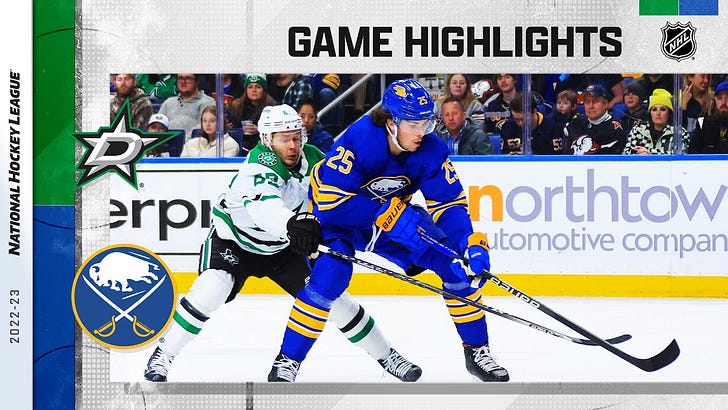Making Sense Of The Dallas Stars' 10-Goal Barrage
It was a monster game — but also a surprising rarity.
If you like goals — and I mean, a lot of ‘em — then the Dallas Stars were your team Thursday night. They sniped a grand total of 10 pucks past hapless Buffalo Sabres netminder Eric Comrie, including 5 in the third period alone. It was a total team effort, too: 10 members of the Stars had multiple points in the game, and 16 got in the scorebook at least once.
Historically speaking, 10-goal games are rare occurrences. Between the regular season and playoffs, there have been only 391 of them in all of NHL history (treating each team’s 10-goal effort as a separate entry, so an 11-10 contest would count twice in the data); of those, only 90 took place on the road like the Stars’ victory did. But Dallas’ barrage marked the fourth double-digit scoring game in the NHL over the past two seasons, further proof that leaguewide scoring is on the uptick after years of struggle.
If you look at the history of 10-goal games, though, it’s clear that we aren’t getting as many of them as we might expect based on the current scoring environment — making Dallas’ accomplishment surprisingly rare in the modern game.
We can see just how uncommon these kinds of massive scoring outputs are this century if we simply plot out the number of 10+ goal games by season in NHL history:
Thursday’s game was the first (and only) 10-goal game of 2022-23 so far, bringing this season a third of the way toward last year’s tally. But we’re already ahead of the season before that — and many others of recent vintage — which featured zero 10-goal games. In fact, exactly as many NHL seasons since 1999-2000 (12) have featured no 10-goal games at all as have featured at least one.
That’s a far cry from the high-octane 1980s, which contained at least six 10-goal games in every season of the decade, and saw a record 23 (!) double-digit scoring games in 1981-82, the same year Wayne Gretzky set the all-time NHL single-season goal mark at 92 tallies. The last time there were even 10 double-digit scoring games in a season was 1992-93, which saw teams do it 17 times, and there hasn’t been a season with five games of 10+ goals since 1995-96.
None of this is especially shocking; students of hockey history know that modern league scoring peaked in the ‘80s and went downhill during the ‘90s and into the 2000s as part of the loathsome Dead Puck Era. But what’s strange about the relative paucity of recent 10-goal games is that it stands at odds with the current NHL’s increase in scoring rates.
Here’s a plot of 10-goal game frequency (as a share of total games) versus league goals per game for every regular season in NHL history, along with a weighted LOESS curve showing the trend between the two variables:
Generally speaking, there isn’t much of a positive relationship between leaguewide scoring and the frequency of 10+ goal games until the average game gets above the 3.0 GPG threshold — at which point, the odds of a double-digit scoring contest starts to slowly rise. (This makes sense, as 10+ goal games are quite rare overall, happening once every 324 team-games over the course of NHL history.) The 2022-23 season is above that level, part of a six-year trend of seasons that were either above or close to 3.0 GPG after a decade of mostly never approaching it.
In other words, we’re starting to be in the territory where you might just expect to see some 10-goal games happen every so often. And indeed, we have seen a few these past couple of years. But are we seeing enough of them?
Based on the smoothed curve above, we’d have expected a league like the 2022-23 NHL (with 3.17 GPG) to produce a 10+ goal game 0.25% of the time, or 5.24 times in 2,066 team-games. Instead, it’s happened only once, or 0.05% of the time. And that shortfall has been true a lot in recent years. Since 2009-10, only one season (2016-17) has seen the number of 10+ goal games exceed the number we’d expect based on the league’s overall scoring environment. Over that same span, the league has produced just nine double-digit scoring contests, against an expectation of 32.7 — a shortfall of 23.7 total games, or 1.7 per season. Nearly two-thirds of that deficit has come in the past five years alone, as league scoring started to tick up but massive single-game scoring outputs didn’t.
Why is this happening? It could be salary cap-related parity, with more evenly matched teams being able to resist the opponent’s urge to pile up as many goals as possible. It could be how goals are scored in the modern game — there are far fewer power plays now than in earlier high-scoring seasons, meaning more goals must be scored at 5-on-5, rather than on reliable set plays with the man advantage that great teams can spam. Defenders are generally far more competent than they were in Gretzky’s heyday, and goaltending has evolved even more. So teams could be better at evolving to combat tactics that would have worked again and again back in the day. Or maybe when one side scores a lot and has a big lead, it tends to “load manage” and take its foot off the gas nowadays.
No matter the reason, what we saw from Dallas this week was an extraordinary scoring outburst. It might not have been fun for poor Comrie, whose save percentage now sits at an ugly .877 on the season, but it was the kind of scorefest that belongs to a different era of the game — and one which we don’t see nearly as often as we probably should in today’s game.






